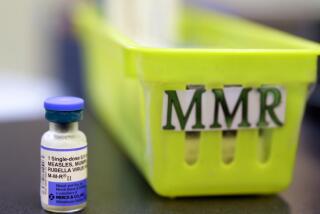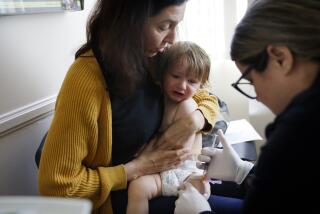Health Officials in O.C. Praise President’s Plan
- Share via
President Clinton’s plan to provide free vaccines was hailed Friday by health officials in Orange County, where authorities say half of all preschool children are not fully immunized and 25% of children under age 2 are not immunized at all.
“Short of providing clean water and a sewer system, immunization is the most effective preventive-health measure ever devised by man,” said immunization advocate Dr. David J. Lang, head of infectious diseases for Children’s Hospital of Orange County.
Even though shots are now available for free at county clinics, there are many roadblocks, officials say. The cost of vaccines has jumped dramatically during the past few years, there are only a few public health offices where shots can be administered and the operating hours are limited.
As part of the health initiative, Clinton intends to ask Congress to approve an additional $300 million for vaccination programs. Local health professionals said they hope the money can be used to open more neighborhood clinics and expand operating hours.
“People can go to the clinic and get the vaccinations,” Lang said. “The county hasn’t been able to get out to the community, and hopefully we’ll be able to provide that. . . . We have neighborhood rabies clinics for dogs, and we do not do the same for our children. It seems bizarre to me.”
Highlighting the importance of immunization is another priority, health professionals said. Not everyone knows that free vaccinations are available, said Dianna DeVane, chairwoman of Orange County Immunization Coalition, which is a chapter of a national effort to raise the immunization rate.
Education may be needed for the county’s immigrant population, where the immunization rate is very low. But the lack of immunization isn’t restricted to the newcomers and the poor.
“There is a certain complacency,” Lang said. “People forget what these diseases look like, even people who can afford” immunization.
Low immunization rates also reflect the growing proportion of children who are uninsured. A UCLA study found that 26% of Orange County children are not covered at some point in a given year. Even those who have insurance are not always covered for immunizations. Only 45% of conventional employment-based plans will pay for vaccinations.
Doctors recommend that infants get their first immunization shot for hepatitis B at birth, for polio, diphtheria or diphtheria/tetanus between 2 and 4 months of age, and for measles, mumps and rubella when they are 12 to 15 months old. School-age children should have a second vaccination.
State law requires children to be immunized against those diseases before being admitted to kindergarten or preschool.
Also, health professionals and young people in their first year of college are required to be immunized against measles.
Despite the law, about 5% of California students escape the immunization requirement. Parents can avoid the shots by signing a waiver for their children, DeVane said. And in some heavily immigrant neighborhoods, school officials sometimes look the other way.
“It’s a tough situation for teachers and administrators,” DeVane explained. “Are we going to have children unvaccinated and in school, or out of school and unvaccinated?”
Experts say the immunization process should start before a child reaches school age.
“It’s not the 5-year-olds starting school that is a major concern,” DeVane said. “It’s the 2-, 3- and 4-year-olds.”
Part of Clinton’s program involves trying to lower the prices that drug manufacturers charge for vaccines.
The nation’s second largest drug wholesaler, Bergen Brunswig Corp., is based in Orange. But Chief Financial Officer Neil Dimick said only a small portion of the company’s sale comes from vaccines.
Dimick, who has been outspoken against regulating drug prices, said that his company is “watching very closely” to see what the Clinton Adminstration would do. “Things are evolving very quickly.”
Times staff writer Jim Gomez contributed to this report.
Immunization Schedule
Childhood vaccinations should begin when an infant is 2 months old. The schedule and types of shots:
Age Shots needed At birth Hepatitis B 1-2 months Second hepatitis B 2 and 4 months Polio, DTP (diphtheria, tetanus, pertussis), Hib (haemophilus influenza Type B) 6 months DTP, Hib, third hepatitis B 12 months MMR (measles, mumps, rubella) 15 months Polio, DTP, Hib 4-6 years Polio, DTP, MMR 14-16 years Tetanus Every 10 years Tetanus
Source: Los Angeles Times reports
More to Read
Sign up for Essential California
The most important California stories and recommendations in your inbox every morning.
You may occasionally receive promotional content from the Los Angeles Times.













